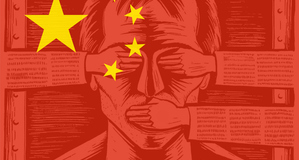The American Military and the Press: From Vietnam to Iraq
By
2009, Vol. 1 No. 10 | pg. 1/1
KEYWORDS:
“News is something someone wants suppressed,” British newspaper baron Lord Northcliffe once said. “Everything else is just advertising.” This point is especially true in war journalism where every story, be it a heart-warming depiction of troops handing out candy to local children or a gut-wrenching depiction of the horrors of war, can be construed as propaganda. Militaries of countries that protect the freedom of the press know that it is through the press that their performance, whether a success or a failure, will be conveyed to the people they represent. In today’s world of satellite links and e-mail the relationship between a war correspondent, his audience, and the war he is covering is more complicated than ever. It is now possible for citizens of a country to watch their military fight a war on the other side of the globe in real time. As a result, the military can be held accountable for its actions as they happen, which makes modern war coverage less subject to government censorship then ever before. This can create a danger for military units as reporters often don’t understand the logistics of war enough to know what information will be useful to the enemy. (Lord Northcliffe also stated that journalism is “a profession whose business is to explain to others what it personally does not understand.”) The history of American armed conflict in the TV era, from Vietnam to the Iraq War, is also a history of how the U.S. military has learned to adapt to the rapid expansion of communication technology during that same period. In Vietnam, reporters were generally allowed to go anywhere and report anything that wasn’t classified. The fact that Vietnam was the first “television war” may be a great a factor as any in the large public opposition that in the conflict’s later years. Many conservatives still argue that Vietnam was winnable, if only the media hadn’t stabbed the military in the back. Learning from those lessons, the military became increasingly skeptical of the media (and vice versa) and sought to keep the media from reporting on operations in Central America in the 1980’s. The digital age of satellites and twenty-four-hour news networks was just being born, and to deny it a place on the battlefield was a shortsighted and unpractical solution to the problem of preventing the media from reporting embarrassing or sensitive information. After all, not allowing the media to report anything was far more damaging to the credibility of the military than any individual story could be. The solution between the extremes of Vietnam and the Gulf War lies in the strategy engineered by the Bush administration for the current Iraq War: the embedded reporter. Restraints on press freedoms during war have existed since the process of publication was fast enough that information in the press could be relevant and useful to the sides engaged in a conflict as well as have an immediate effect on public opinion. The first major example of wartime reporting having a persuasive effect on the home front was William Howard Russell’s reporting on the Crimean War in The Times of London. Russell’s depictions of the Crimean battlefield “so shocked the English public that the Cabinet fell as a result, and the tolerance of British officialdom toward battlefield journalism fell with it” (Jacobs, 680). The public information specialist and a war report bureau were introduced by various militaries in World War I to control, or at least influence, the flow of information from the battlefield. During World War II, journalists were given free access in the European theater, sometimes even parachuting into combat zones or riding in bombers, but General Douglas MacArthur was far more stringent and manipulative with the press in the pacific (Jacobs, 682). The military did not have a uniform policy for how to handle journalists. Censors were pervasive in Korea, but the system was far from uniform, and many journalists protested the lack of clear guidelines. Throughout all the engagements prior to Vietnam there was often pre-publication review or censorship by restricting access. In Vietnam there was neither.Although the press still had to abide by basic agreements which restricted the publication of sensitive information that might be harmful to operations in progress, there was little censorship. This may be attributable to President Johnson’s assertion that the Vietnam War was not in fact a war, and that setting up the necessary wartime censorship apparatus would be obviously hypocritical (Jacobs, 683). It can also be presumed that the administration, and indeed the world at large, simply didn’t fully appreciate the paradigm shift in war reporting that occurred with the widespread use of television journalism and the nightly images of bloodshed that it brought into American homes. By the 1980’s the military was extremely distrustful of the media (there are still right wing pundits who claim it was the media who lost the Vietnam War) and that distrust manifested itself in a new attitude toward the press’s right to battlefield access. Matthew Jacobs points out that during the invasion of Grenada in 1983, the press corps “was left behind on a neighboring island and was not permitted onto Grenada for two days. Some journalists,” he continues, “chartered boats in an attempt to reach Grenada independently, but were intercepted and held on a navy ship for two days” (Jacobs, 684). While the invasion of Grenada was a relatively minor engagement, the new disdainful attitude that the military had shown there to the press was on full display in the Gulf War, the largest U.S. military action since the Vietnam War. “Since the Grenada conflict,” the New York Times Magazine declared in 1991, “the Pentagon has linked victory with censorship” (Norris, 224). Censorship during the Gulf War was unique in American history because it depended on pre-censorship, or a denial of information to the reporter instead of post-censorship, which denies the reporter the ability to share information with the people. In legal circles pre-censorship is known as “prior-restraint” and the Supreme Court has always ruled it unconstitutional, even when the information was classified, as in the case of the Pentagon papers. Anticipating the attitude of the military toward press coverage in the build up to the Gulf invasion, a large contingency of media outlets, led by The Nation, sued the defense department for access to the military front during the coming war. The case was eventually thrown out. Before a Senate Committee on Governmental Affairs in 1991, Walter Cronkite warned of the danger of the way the military barred the media from the battlefield. As described by Margot Norris, Cronkite “warned that unlike the provisional and temporary censorship of reportage in World War II or Vietnam, the prior limitation and control of access to combat news made the data and firsthand accounts needed for the historiography of the Persian Gulf War irretrievable” (Norris, 225). Despite complaints about media access, the Gulf War was both a military and political success. But the Persian Gulf was a fairly quick, conventional war against an opponent who was overwhelmed by force and technology. For any long term guerrilla war, especially one that would require public support and patience, a media blackout would do more harm than good. Although the architects of the current Iraq War did predict a quick decisive victory in which American troops were greeted as liberators, they handled the uneasy relationship between media and military with a far more nuanced approach then their predecessors. Recent history gave them two examples, both of which were not arrangements to model policy after. One was the general absence of media restrictions in Vietnam, which resulted in politically damaging material appearing on the evening news. The other was the censorship and prior-restraint of the first Gulf War, which could not be sustained over a long period of time (never mind whether or not it was constitutional policy.) Instead, they choose a middle path. They would get the reporters close to the battlefield, allowing them access to the front lines, but “embed” them within a military unit. This strategy effectively used a carrot and stick to get reporters to tell the story the military wanted told. The carrot is the access to the front lines, the ability to talk to real soldiers as they fought. The stick is not overt, and that is why the strategy is so effective: it is the general force of social cohesion that pressures the reporter to not report negative things on the people he is living with and depending on for protection. “There’s […] something subtly subversive about this policy,” Jonathan Alter wrote in March of 2003. In effect, the embedded reporter policy sets up a situation in which the reporter himself loses objectivity and begins to self-censor. Although the many members of the media were aware of the pitfalls of such an arrangement, the opportunity to have live images from the battlefield resulted in most reporters jumping at the opportunity to ride into battle with military units. “It could be groundbreaking—a fascinating piece of insight into how the military actually does it,” said CNN anchor Bill Hemmer from Kuwait before the actual invasion (Johnson, 1). David Martin, a veteran CBS correspondent, predicted that that “this is going to be a war like no other we’ve ever seen” (Johnson). 500 reporters were embedded with the military in the Iraq invasion, and despite all the predictions of a whole new war experience, there is not one iconic image from the Iraq War, with the exception of Saddam’s statue being torn down by civilians, which later turned out to be largely staged. The current situation in Iraq is far different from the days of the early invasion. As the Iraq War dragged on for longer than planned there were widespread reports of soldiers confiscating and destroying journalist’s materials. When things go wrong it is far more likely that embedded reporters will be outright bullied by soldiers. "Our journalists in Iraq have been shoved ot the ground, pushed out of the way, told to leave the scene of explosions; we've had camera disks and videotapes confiscated, reporters detained," says Sandy Johnson, Washington Bureau chief for the Associated Press. On November 12, Johnson sent a letter to the Pentagon, signed by thirty media companies, which cited their concern at "a grwoing number of incidents in Iraq in which journalists are harassed by U.S. troops in the course of covering the news" (Rosen). Historically, military censorship has been imposed from the top down. This is no longer possible in an era of satellite phones and internet access in third world locations. The embedded reporter policy understands this, and instead tries to align pre-existing forces (the journalist’s desire to be at the front lines, the natural tendency to not bite the hand that feeds) in such a way to produce an organic, bottom up, self-regulating censorship. Alter, Jonathan. “In Bed With The Pentagon.” Newsweek. 10 March 2003: 45. Jacobs, Matthew. “Assessing the Constitutionality of Press Restriction in the Persian Gulf War.” Stanford Law Review. 44.3. February, 1992: 675-726. Johnson, Peter. “Media’s War Footing Looks Solid.” USA Today. 17 February, 2003: 1D. Norris, Margot. “Military Censorship and the Body Count in the Persian Gulf War.” Cultural Critique. Autumn 1991: 223-245. Rosen, Laura. “Journalists Take Flack in Iraq.” The Nation. 24 December, 2003. http://www.thenation.com/doc/20040112/rozen Suggested Reading from Inquiries Journal
Inquiries Journal provides undergraduate and graduate students around the world a platform for the wide dissemination of academic work over a range of core disciplines. Representing the work of students from hundreds of institutions around the globe, Inquiries Journal's large database of academic articles is completely free. Learn more | Blog | Submit Latest in Political Science |














